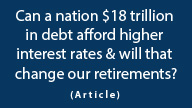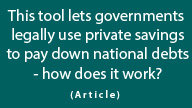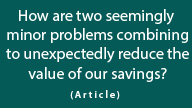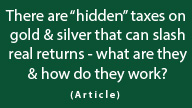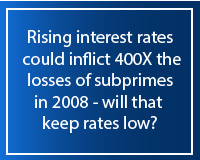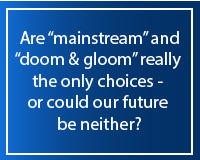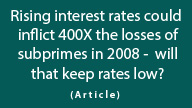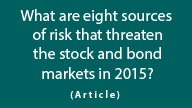US Regulators Mandate Next Stage Of Textbook Financial Repression
by Daniel R. Amerman, CFA
Below is the 2nd half of this article, and it begins where the 1st half which is carried on other websites left off. If you would prefer to read the article in single page form, or share via Facebook or Twitter, the one page version for subscribers can be found here:
Mandated "Safety" Raises The Fence
What is also a classic, textbook element of Financial Repression is that the forced funding of government debt is presented as being mandated by the need to increase safety for the public.
In the case of banks, we all know the government considers them risky (as they are), and the government wants the banks to be safer. Legally, the highest quality form of asset that a bank can have is reserves on deposit at the Federal Reserve. So from a regulatory and political perspective, this isn't about forcing depositors to lend money to the government at absurdly low rates. Not at all.
Instead for the good of the public, the banks need to be safer. Which means the banks are encouraged to put trillions of dollars of the public's deposits in the safest place they can, which is the Federal Reserve. Which then puts that money in the safest place it can, which is buying US government debt. So when the public has almost no interest income, and the heavily indebted government has some of the lowest interest costs in financial history, that is just a fortuitous coincidence, so to speak. The real reason is the safety of the public.
Or so the story goes.
The wording in this Wall Street Journal article about the change in money fund investments is quite interesting. These financial companies are not being reluctantly forced to invest their money in US government obligations but rather the headline is that they are clamoring to do so. It turns out that they just can't get enough of these good zero percent returns!
It is only when one gets below the headlines that we learn that the reason for these regulatory changes is (surprise) a need to protect the safety of the public.
"The rules driving the changes aim to protect the $2.7 trillion money-fund industry from a repeat of the 2008 investor withdrawals that resulted in one fund “breaking the buck,” or reporting a net asset value below the full face value of their holdings.
The rule changes won’t apply to funds that invest only in the debt of the federal government and agencies such as Fannie Mae and Freddie Mac."
Wall Street Journal, October 20, 2015
So the fence completes, much more of the $2.7 trillion of money fund industry assets must now be invested in near zero percent government debts, and this is all being done for our own safety.
What is particularly interesting is the contradiction in terms, when it comes to enforcing a move to zero interest rate investments that is supposedly occurring because of the increased risk in the system.
In theory, investors would refuse to accept interest rates below the actual rate of inflation, and in risky environments, they would not be making any investments at all without receiving strong risk premiums for taking on the risk.
However, with a zero percent yield (as some US treasuries are now offering again), the public receives compensation for neither inflation nor systemic risk. There simply isn't room.
Which is exactly why participation needs to be forced. And the textbook way of doing so is in the name of safety.
 What you have just read is an "eye-opener" about one aspect of the often hidden redistributions of wealth that go on all around us, every day.
What you have just read is an "eye-opener" about one aspect of the often hidden redistributions of wealth that go on all around us, every day.
 A personal retirement "eye-opener" linked here shows how the government's actions to reduce interest payments on the national debt can reduce retirement investment wealth accumulation by 95% over thirty years, and how the government is reducing standards of living for those already retired by almost 50%.
A personal retirement "eye-opener" linked here shows how the government's actions to reduce interest payments on the national debt can reduce retirement investment wealth accumulation by 95% over thirty years, and how the government is reducing standards of living for those already retired by almost 50%.
 An "eye-opener" tutorial of a quite different kind is linked here, and it shows how governments use inflation and the tax code to take wealth from unknowing precious metals investors, so that the higher inflation goes, and the higher precious metals prices climb - the more of the investor's net worth ends up with the government.
An "eye-opener" tutorial of a quite different kind is linked here, and it shows how governments use inflation and the tax code to take wealth from unknowing precious metals investors, so that the higher inflation goes, and the higher precious metals prices climb - the more of the investor's net worth ends up with the government.
 Another "eye-opener" tutorial is linked here, and it shows how governments can use the 1-2 combination of their control over both interest rates and inflation to take wealth from unsuspecting private savers in order to pay down massive public debts.
Another "eye-opener" tutorial is linked here, and it shows how governments can use the 1-2 combination of their control over both interest rates and inflation to take wealth from unsuspecting private savers in order to pay down massive public debts.







If you find these "eye-openers" to be interesting and useful, there is an entire free book of them available here, including many that are only in the book. The advantage to the book is that the tutorials can build on each other, so that in combination we can find ways of defending ourselves, and even learn how to position ourselves to benefit from the hidden redistributions of wealth.


